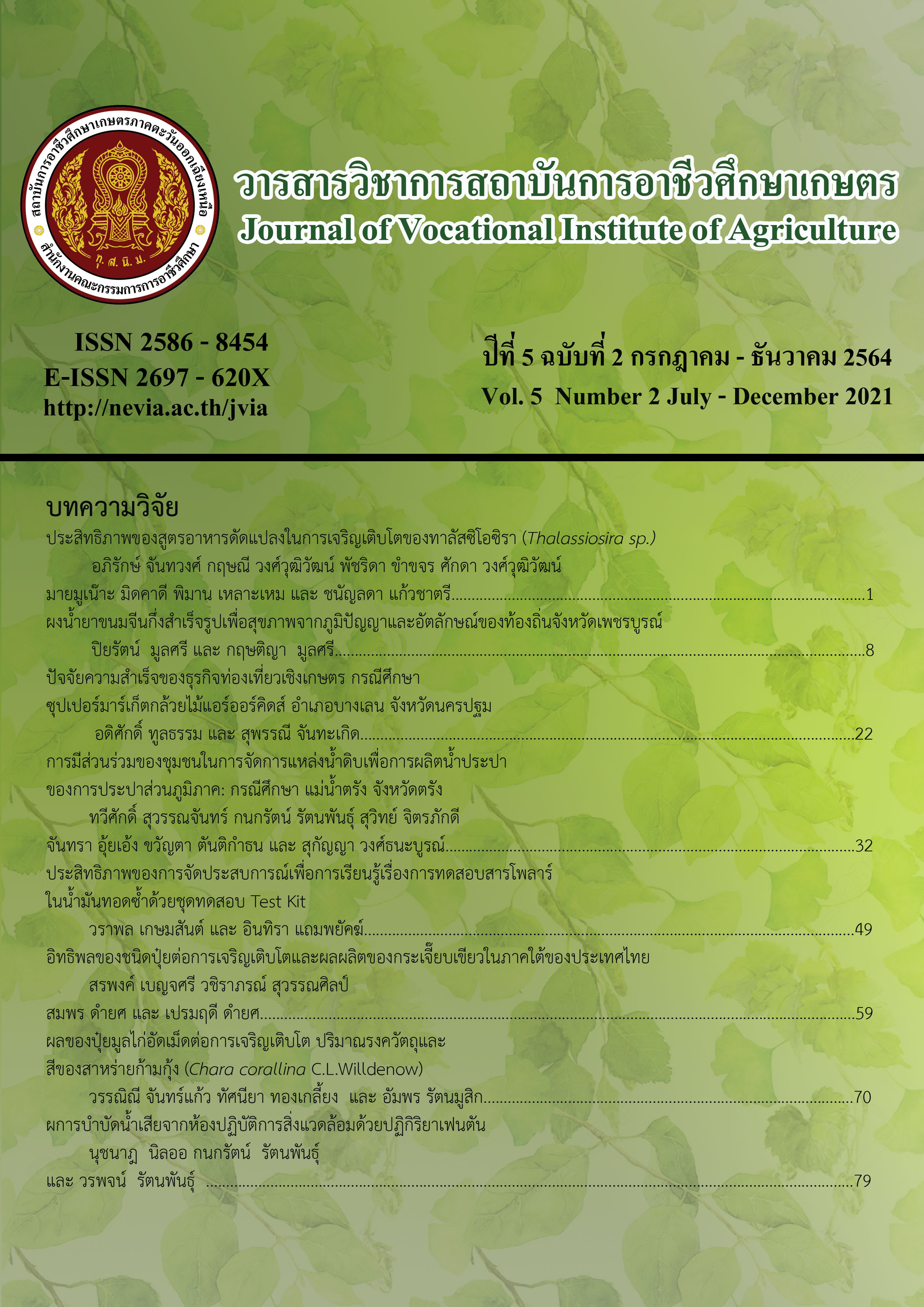อิทธิพลของชนิดปุ๋ยต่อการเจริญเติบโตและผลผลิตของกระเจี๊ยบเขียวในภาคใต้ของประเทศไทย
Main Article Content
บทคัดย่อ
ทำการศึกษาอิทธิพลของปุ๋ยต่อการเจริญเติบโตและผลผลิตของกระเจี๊ยบเขียว โดยทำการปลูกกระเจี๊ยบเขียวและใส่ปุ๋ยชนิดต่างๆ (ทรีตเมนต์) ซึ่งแบ่งการทดลองออกเป็น 5 ทรีตเมนต์ ประกอบด้วย ชุดควบคุมที่ไม่มีการใส่ปุ๋ยตลอดการทดลอง (Tr1), ปุ๋ยเคมี (Tr2), ปุ๋ยมูลสุกร (Tr3), ปุ๋ยมูลโค (Tr4) และ ปุ๋ยมูลไก่ (Tr5) มีการวางแผนการทดลองแบบสุ่มภายในบล็อกสมบูรณ์ โดยทดลองทรีตเมนต์ละ 4 ซ้ำ ๆ ละ 10 ต้น ณ คณะเทคโนโลยีและการพัฒนาชุมชน มหาวิทยาลัยทักษิณ วิทยาเขตพัทลุง ผลการทดลอง พบว่าจำนวนฝักต่อต้นของกระเจี๊ยบเขียวที่ใส่ปุ๋ยมูลสุกร มีจำนวนฝักมากที่สุดคือ 65.23 ฝัก/ต้น ซึ่งมีความแตกต่างทางสถิติอย่างมีนัยสำคัญ (P≤0.05) กับการใส่ปุ๋ยมูลโค ปุ๋ยมูลไก่ ปุ๋ยเคมี และทรีตเมนต์ควบคุม (ไม่ใส่ปุ๋ย) โดยมีจำนวนฝักเท่ากับ 54.94, 54.87, 50.62 และ 17.87 ฝัก/ต้น ตามลำดับ และเมื่อนำผลผลิตมาศึกษาน้ำหนักต่อฝักพบว่าการใส่ปุ๋ยทั้ง 4 ชนิดไม่แตกต่างกัน (P>0.05) แต่จะแตกต่างทางสถิติกับการไม่ใส่ปุ๋ย โดยการใส่ปุ๋ยเคมี, ปุ๋ยมูลสุกร, ปุ๋ยมูลไก่ และปุ๋ยมูลโค มีนำหนักฝักเท่ากับ 22.71, 22.59, 22.46 และ 22.46 กรัม/ฝัก ตามลำดับ ส่วนทรีตเมนต์ควบคุม (ไม่ใส่ปุ๋ย) มีน้ำหนักต่อฝักน้อยที่สุดเท่ากับ
15.22 กรัม/ฝัก น้ำหนักผลผลิตต่อต้นซึ่งเป็นลักษณะที่สำคัญที่สุดในการศึกษาครั้งนี้ พบว่าการใส่ปุ๋ยมูลสุกรจะทำให้ ผลผลิตของกระเจี๊ยบเขียวมีน้ำหนักดีที่สุดโดยมีค่าเท่ากับ 1,473.55 กรัม/ต้น รองลงมาคือการใส่ปุ๋ยมูลโค ปุ๋ยเคมี และปุ๋ยมูลไก่ มีค่าไม่แตกต่างทางสถิติเท่ากับ 1,218.23, 1,149.58 และ 1,122.64 กรัม/ต้น ตามลำดับ ในขณะที่การไม่ใส่ปุ๋ยในแปลงกระเจี๊ยบส่งผลให้มีน้ำหนักผลผลิต/ต้นน้อยที่สุดเพียง 271.98 กรัม ความแน่นเนื้อพบว่าการใส่ปุ๋ยเคมีมีความแน่นเนื้อสูงที่สุดเท่ากับ 1,110.65 กรัม ในขณะที่ทรีตเมนต์ควบคุม ปุ๋ยมูลไก่ ปุ๋ยมูลโค และปุ๋ยมูลสุกร มีความแน่นเนื้อเท่ากับ 1,009.05, 833.99, 831.86 และ 812.37 กรัม ตามลำดับ ส่วนการเกิดโรคเส้นใบเหลืองและปริมาณแมลงศัตรูมีปริมาณน้อย และไม่มีความแตกต่างทางสถิติ (P>0.05)
Article Details

This work is licensed under a Creative Commons Attribution-NonCommercial-NoDerivatives 4.0 International License.
เนื้อหาและข้อมูลในบทความที่ลงตีพิมพ์ใน Journal of Vocational Education in Agriculture ถือเป็นข้อคิดเห็นและความรับผิดชอบของผู้เขียนบทความโดยตรง ซึ่งกองบรรณาธิการวารสารไม่จำเป็นต้องเห็นด้วยหรือร่วมรับผิดชอบใดๆ
บทความ ข้อมูล เนื้อหา ฯลฯ ที่ได้รับการตีพิมพ์ใน Journal of Vocational Education in Agriculture ถือเป็นลิขสิทธิ์ของJournal of Vocational Education in Agriculture หากบุคคลหรือหน่วยงานใดต้องการนำทั้งหมดหรือส่วนหนึ่งส่วนใดไปเผยแพร่ต่อหรือเพื่อกระทำการใดๆ จะต้องได้รับอนุญาตเป็นลายลักษณ์อักษรจาก Journal of Vocational Education in Agriculture ก่อนเท่านั้น
References
Benchasri, S. (2012) Okra (Abelmoschus esculentus (L.) Moench) as a valuable vegetable of the world. Ratarstvo i povrtarstvo, 49(1), 105-112.
Benchasri, S., et al. (2020). The effect of genotypic variability on the yield and yield components of okra (Abelmoschus esculentus L. Moench) in Thailand. Asian Journal of Agriculture and Biology, 8(4), 480-490.
Gavint, K.N. et al. (2018). To study the nature and magnitude of heterosis for fruit yield and yield attributes in okra [Abelmoschus esculentus (L.) Moench]. Journal of Pharmacognosy and Phytochemistry, 7(1), 2583-2587.
สกุลกานต์ สิมลา และสรพงค์ เบญจศรี. (2558). การประเมินลักษณะทางการเกษตรและผลผลิตของกระเจี๊ยบเขียวในจังหวัดมหาสารคาม. แก่นเกษตร, 43(1), 894-899.
อัญจนา จันทร์ปะทิว และ วรรณพร สิทธิกานต์. (2562). อิทธิพลของระยะปลูกและอัตราการใช้ปุ๋ยเคมีที่มีผลต่อการเจริญเติบโตและองค์ประกอบของผลผลิตกระเจี๊ยบเขียว. แก่นเกษตร, 47(1), 1557-1562.
Bello, B.O. & Aminu, D. (2017). Genetic relationships among okra (Abelmoschus esculentus (L.)Moench) cultivars in Nigeria. Acta agriculturae Slovenica, 109(2), 251-260.
Benchasri, S. (2015). Effects of chemical and organic agricultural systems for okra (Abelmoschus esculentus L. Moench) production in Thailand. Australian Journal of Crop Science, 9(10), 968–975.
Hayaza, S., et al. (2018). Anticancer activity of okra raw polysaccharides extracts against human live cancer cells. Tropical Journal of Pharmaceutical Research, 18(8), 1667-1672.
Lu, Y., et al. (2016). Oligomeric proanthocyanidins are the active compounds in Abelmoschus esculentus Moench for its α-amylase and α-glucosidase inhibition activity. Journal of Functional Foods, 20, 463–471.
Graham, J.O., et al. (2017). Total phenol content and antioxidant activity of okra seeds from different genotypes. American Journal of Food and Nutrition, 5(3), 90-94.
Zhang, T., et al. (2018). Preliminary characterization and anti-hyperglycemic activity of a pectic polysaccharide from okra (Abelmoschus esculentus (L.) Moench). Journal of Functional Foods, 41, 19–24.
สรพงค์ เบญจศรี และชฎารัตน์ บุญจันทร์. (2554). ศึกษาความเป็นไปได้ในการตัดสินใจปลูกกระเจี๊ยบเขียวภายใต้ระบบเกษตรอินทรีย์เพื่อเป็นอาชีพเสริมของเกษตรกร ตำบลบ้านเภอป่าพะยอม จังหวัดพัทลุง. วารสารมหาวิทยาลัยนเรศวร, 19(1), 24 – 32.
Moekchantuk, T. & Kumar, P. (2004). Export okra production in Thailand. Bangkok: Inter-country programme for vegetable IPM in South & SE Asia phase II Food & Agriculture Organization of the United Nations.
สรพงค์ เบญจศรี. (2555). การประเมินการเกิดโรคและแมลงศัตรูพืชของกระเจี๊ยบเขียวในภาคใต้ของประเทศไทย. วารสารวิชาการพระจอมเกล้าพระนครเหนือ, 22(1), 57-66.
Benchasri, S. (2011). Screening for yellow vein mosaic virus resistance and yield loss of okra under field conditions in Southern Thailand. Journal of Animal & Plant Sciences, 12(3), 1676-1686.
Rynjah, S. (2018). Field screening of okra (Abelmoschus esculentus L. Moench) genotypes against okra yellow vein mosaic virus disease. Journal of Pharmacognosy and Phytochemistry, 7(5), 1852-1854.
Tiamiyu, R.A., et al. (2012). Effect of sources of organic manure on growth and yields of okra (Abelmoschus esculentus L.) in Sokoto, Nigerian. Nigerian Journal of Basic and Applied Sciences, 20(3), 213-216.
Nweke, I.A., et al. (2013). Effect of different sources of animal manure on the growth and yield of okra (Abelmoschus Esculentus L.Moench) in Ustoxic Dystropept at Enugu South Eastern,
Nigeria. International journal of scientific & Technology research, 2(3), 135-137.
Adesina, O.L. & Wiro, K.O. (2020). Influence of poultry manure rates on the growth and yield of okra (Abelmoschus esculentus (L.) Moench) in Rivers State. Journal of Experimental Agriculture International, 42(1), 116-120.
Adhikari, A. & Piya, A. (2020). Effect of different sources of nutrient on growth and yield of okra (Abelmoschus esculentus L. Monech). International Journal of Environmental & Agriculture Research, 6(1), 45-50.
Benchasri, S. & Bairaman, C. (2013). Preliminary studies on incidence of insect pests on okra (Abelmoschus esculentus (L.) Moench) in Thailand. Bulgarian Journal of Agricultural Science, 19(2), 209-215.
